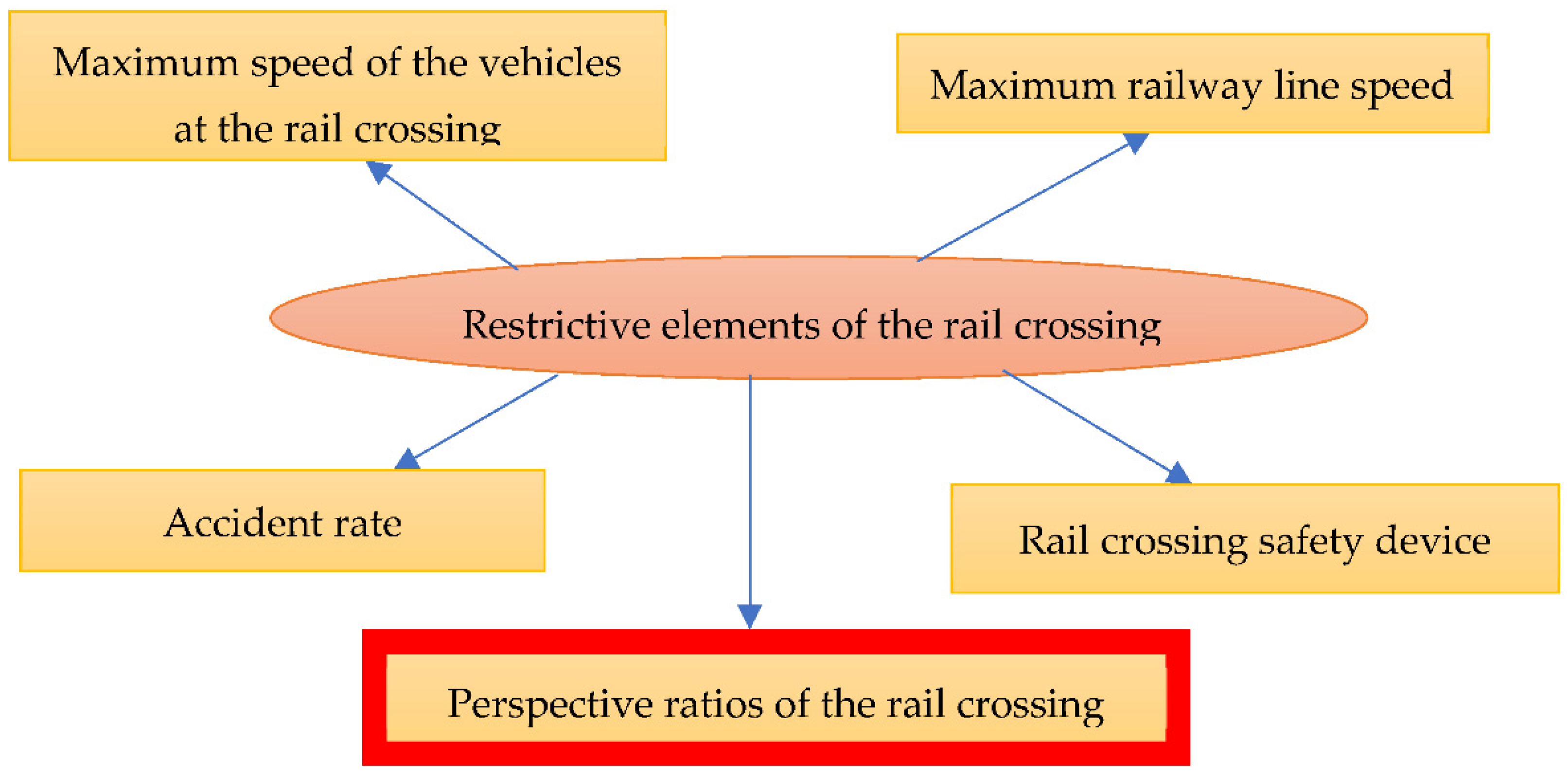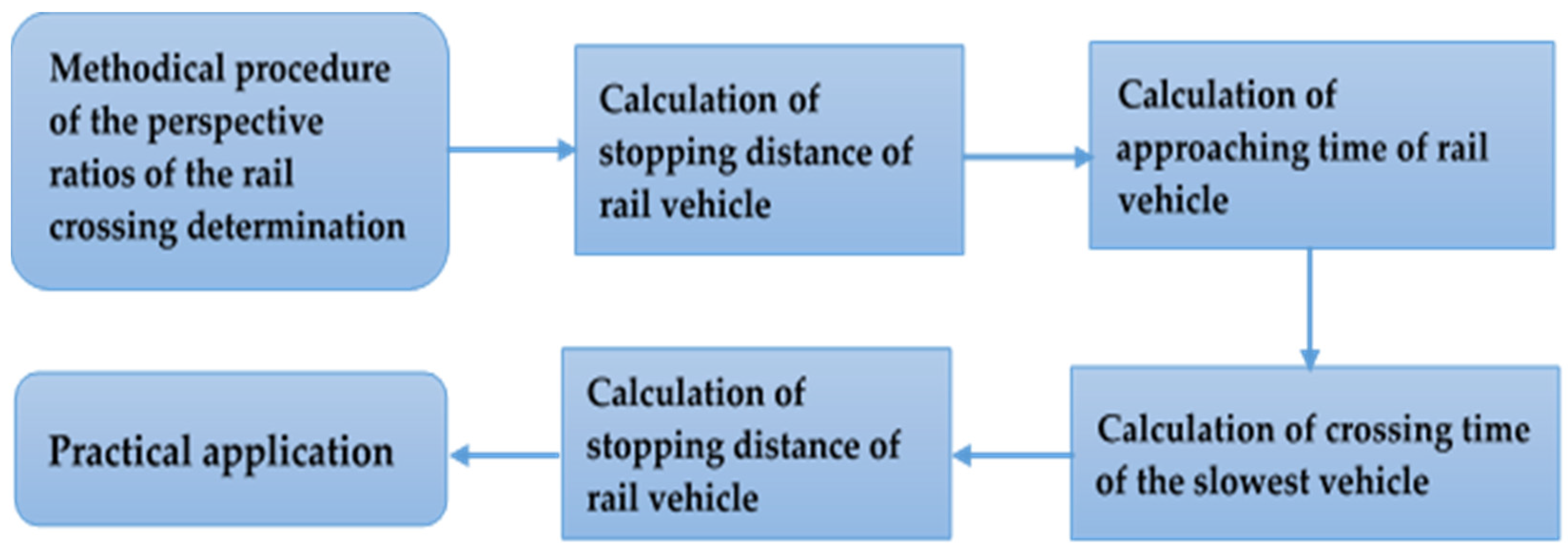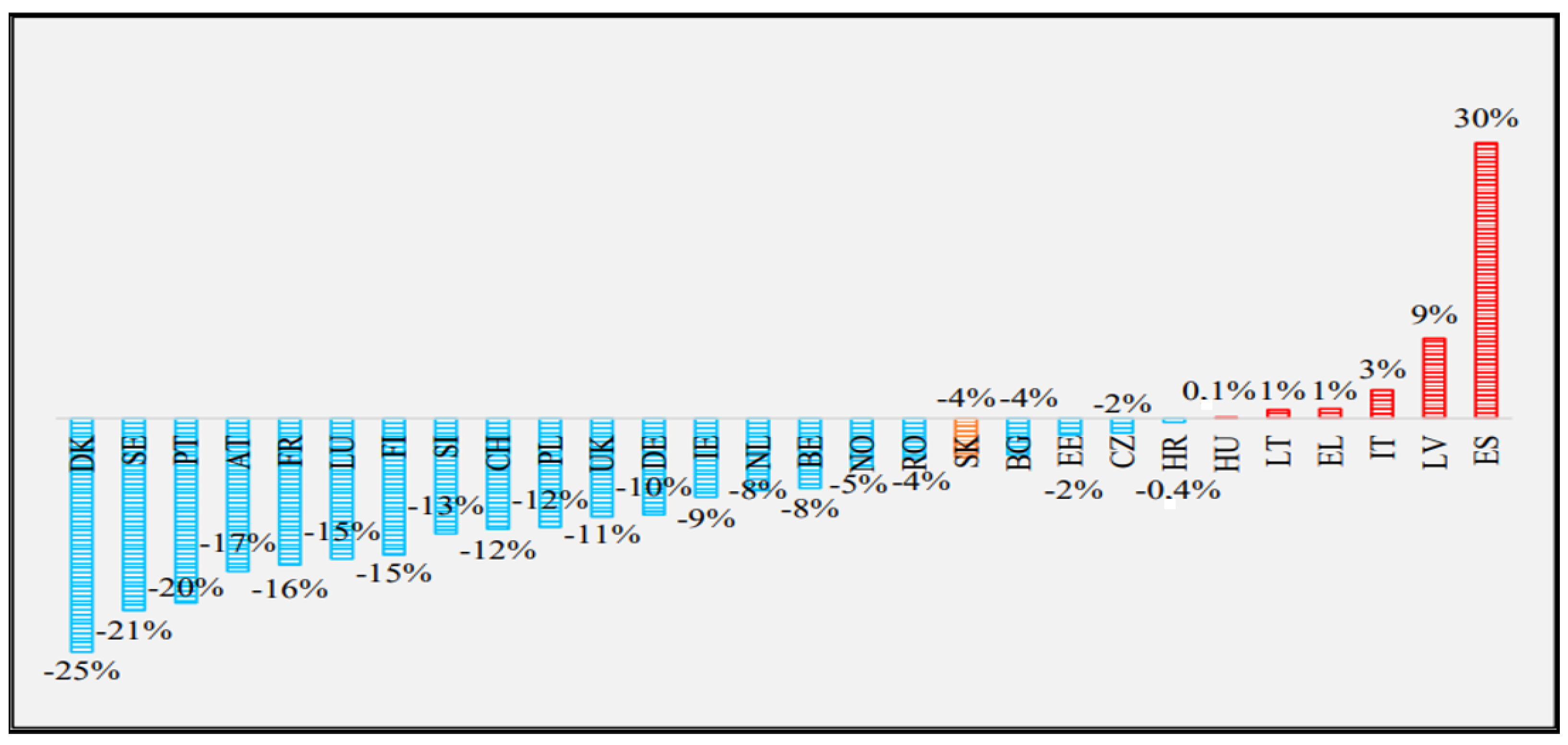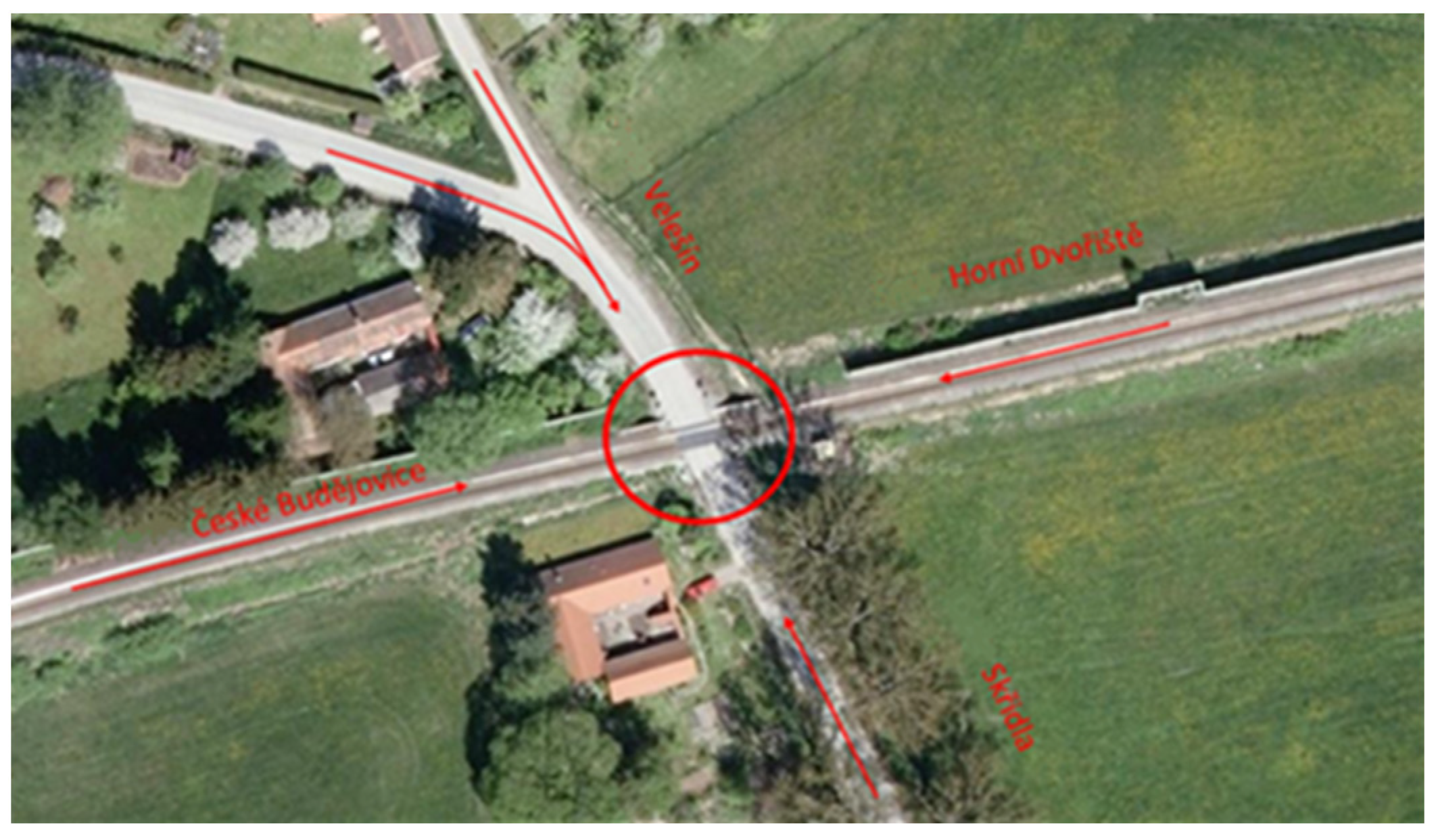Assessment of the Perspective Ratios in Rail Crossings as an Important Evaluation Factor of Rail Crossings
Abstract
:1. Introduction
2. Materials and Methods
2.1. Current Status of the Issue
2.2. Methods
- Brainstorming method—it is known as a creative method used to solve various problems using the generation of progressive ideas and thoughts; the result should be an original and unique solution to a specific problem, which also represents the proposals and outputs listed in the chapter [33];
- mind mapping method—the method develops the brainstorming method, through which the logic of the researched problem, context and priorities are developed [33];
- panel expert method—it is a forecasting method that, based on the input data, provides a vision or recommendations for future options and needs related to the analyzed transport topic; the method involves about 15–20 experts who work on a certain problem for a certain period of time (3–18 months), the basis is the elaboration of final outputs on the basis of joint compromises and joint scientific and professional research [33];
- the system approach method—it is a method that emphasizes the overall picture and the interrelationships and connections between the individual components of the whole, it can be called the science of management, decision-making or the science of systems thinking [33];
- the heuristic method—the method offers and discovers new ways of solving problems and inventing certain new contexts; it is a scientific activity based on a “discovery” procedure, which usually starts with a general proposal or some rough estimate, which is gradually refined; this method represents an intersection between empirical and exact methods [34];
- FMEA (Failure mode and effect analysis) method—it belongs to the basic group analytical methods used in the quality management process, management reliability, and security; it is one of the basic methods used in semi-quantitative risk analysis, applying not only to production processes and products but also services, financial, social and other processes [35];
- SFMEA—(System Failure Mode Effects Analysis)-analyzes systems and subsystems at an early (conceptual) stage and focuses on interactions between systems and system elements [35].
3. Results


3.1. Methodical Procedure Proposal

3.1.1. The Calculation of Stopping Distance of Rail Vehicle
- S—stopping distance of rail vehicle [m];
- sr—travel distance of rail vehicle within the train driver’s reaction time [m];
- sb—travel distance of rail vehicle within the rise time of braking effect [m];
- sz—travel distance of rail vehicle from the rise time of braking effect to the point of stopping the vehicle [m].
- g—gravitational acceleration [m.s−2];
- µ—coefficient of usable adhesion [-].
- vp—initial speed of rail vehicle [m.s−1];
- ab—acceleration of rail vehicle after the rise of braking effect [m.s−2];
- tb—time of the rise of braking system [s].
- vz—speed of rail vehicle after the rise of braking effect [m.s−1];
- az—acceleration of rail vehicle on the rise of braking effect [m.s−2].
- tr—train driver’s reaction time;
- tz—time from the rise of braking effect to the point of stopping the vehicle.
3.1.2. Calculation of Approaching Time of Rail Vehicle
- sr—viewing distance of the slowest vehicle;
- vt—line speed.
3.1.3. Calculation of Crossing Time of the Slowest Vehicle
- sp—distance from the warning device to the external edge of the danger zone of crossing [m];
- vnv—speed of the slowest vehicle [m.s−1].
3.1.4. Calculation of Stopping Distance of Rail Vehicle
3.2. Practical Application of the Methodology at Rail Crossing P5567
3.2.1. Possibilities of Avoiding Collisions in the Direction of Horní Dvořiště
3.2.2. Possibilities of Avoiding Collisions in the Direction of České Budějovice
3.2.3. Possibility of Avoiding Collisions by the Passenger Vehicle Driver at Crossing P5567
4. Discussion
5. Conclusions
Author Contributions
Funding
Institutional Review Board Statement
Informed Consent Statement
Data Availability Statement
Conflicts of Interest
References
- Berger, U.; James, P.; Lawrence, A.; Roggenbach, M.; Seisenberger, M. Verification of the European rail traffic management system in real-time maude. Sci. Comput. Program. 2018, 154, 61–88. [Google Scholar] [CrossRef] [Green Version]
- Starčević, M.; Barić, D.; Pilko, H. Safety at Level Crossings: Comparative Analysis. In Proceedings of the Cetra 2016 4th International Conference on Road and Rail Infrastructure IV, Šibenik, Croatia, 23–25 May 2016. [Google Scholar]
- Ľupták, V.; Hlatká, M. Rolling stock stopping for different railway line speeds and different coefficients of usable grip: A case study. In Proceedings of the 22nd International Scientific Conference Transport Means 2018, Trakai, Lithuania, 3–5 October 2018; Kaunas University of Technology: Kaunas, Lithuania, 2018; pp. 216–224. Available online: https://transportmeans.ktu.edu/wp-content/uploads/sites/307/2018/02/Transport-means-I-dalis-2018-09-25.pdf (accessed on 10 June 2022).
- Ministry of Transport, Construction and Regional Development of the Slovak Republic. Strategy for the Development of Public Passenger and Non-Motorized Transport in the Slovak Republic until 2020. [Online]; 2014; p. 68. Available online: https://www.mindop.sk/ministerstvo-1/doprava-3/strategia/strategicky-plan-rozvoja-dopravy-sr-do-roku-2030 (accessed on 10 June 2022).
- Laapotti, S. Comparison of fatal motor vehicle accidents at passive and active railway level crossings in Finland. IATSS Res. 2016, 40, 1–6. [Google Scholar] [CrossRef] [Green Version]
- Vilotijević, M.; Lazarević, L.; Popović, Z. Railway/Road Level Crossing Design—Aspect of Safety and Environment. In Energy Management of Municipal Transportation Facilities and Transport; Springer: Cham, Switzerland, 2017; pp. 791–800. [Google Scholar]
- Kampczyk, A. Irregularities in level crossings and pedestrian crossings. In TranSopot Conference; Springer: Cham, Switzerland, 2018; pp. 249–261. [Google Scholar]
- Nikolajevs, A.; Mezitis, M. Level crossing time prediction. In Proceedings of the 57th International Scientific Conference on Power and Electrical Engineering of Riga Technical University (RTUCON), Riga, Latvia, 13–14 October 2016; IEEE: Piscataway, NJ, USA, 2016; pp. 1–3. [Google Scholar]
- Ishak, S.Z.; Yue, W.L.; Somenahalli, S.V.C. The Methodology Development of Railway Level Crossing Safety Systems—South Australia Case Study; WIT Press: Southampton, UK, 2008; Volume 103, pp. 629–637. [Google Scholar]
- Yildiz, K.; Kinaci, H. Evaluation of Safety Performance of Level Crossings in Turkey with Data Envelopment Analysis. Sains Malays. 2021, 50, 1113–1120. [Google Scholar] [CrossRef]
- Barić, D.; Havârneanu, G.M.; Măirean, C. Attitudes of learner drivers toward safety at level crossings: Do they change after a 360° video-based educational intervention? Transp. Res. Part F Traffic Psychol. Behav. 2020, 69, 335–348. [Google Scholar] [CrossRef]
- Huang, M.L.; Brill, P. A level crossing density estimation method. Nonlinear Anal. Theory Methods Appl. 1997, 30, 4403–4414. [Google Scholar] [CrossRef]
- Blaho, P.; Pečený, L.; Gašparík, J. Causality of accidents at railway-crossings in Slovakia and its prevention. In Proceedings of the XII International Science-Technical Conference AUTOMOTIVE SAFETY, Kielce, Poland, 21–23 October 2020; IEEE: Piscataway, NJ, USA, 2020; pp. 1–6. [Google Scholar]
- Márquez, F.P.G.; Pedregal, D.J.; Roberts, C. New methods for the condition monitoring of level crossings. Int. J. Syst. Sci. 2015, 46, 878–884. [Google Scholar] [CrossRef]
- Li, C.W.; Chu, C.C.; Fong, W.L.; Wang, H.C. Intelligent level crossing safety control system. In Proceedings of the Tenth International Conference on Intelligent Information Hiding and Multimedia Signal Processing, Kitakyushu, Japan, 27–29 August 2014; IEEE: Piscataway, NJ, USA, 2014; pp. 799–802. [Google Scholar]
- Bureika, G.; Komaiško, M.; Jastremskas, V. Modelling the ranking of Lithuanian railways level crossing by safety level. Transp. Probl. 2017, 12, 11–22. [Google Scholar] [CrossRef] [Green Version]
- Lampa, M.; Smolejová, M. Fleet Optimalization Based on the Monte Carlo Method. Acta Logist. 2020, 7, 17–21. [Google Scholar] [CrossRef]
- Pellegrini, P.; Marlière, G.; Rodriguez, J. Optimal train routing and scheduling for managing traffic perturbations in complex junctions. Transp. Res. Part B Methodol. 2014, 59, 58–80. [Google Scholar] [CrossRef] [Green Version]
- Sun, Q.; Wang, X.; Ma, F.; Han, Y.; Cheng, Q. Synergetic Effect and Spatial-Temporal Evolution of Railway Transportation in Sustainable Development of Trade: An Empirical Study Based on the Belt and Road. Sustainability 2019, 11, 1721. [Google Scholar] [CrossRef] [Green Version]
- Kontaxi, E.; Ricci, S. Techniques and Methodologies for Railway Capacity Analysis: Comparative Studies and Integration Perspectives. In Proceedings of the 3rd International Seminar on Railway Operations Modelling and Analysis, Zurich, Switzerland, 11–13 February 2009; Volume 11–13. [Google Scholar]
- Nachtigall, P.; Široký, J.; Tischer, E. Assessing the efficiency of increasing the track speed in the line section Rokycany—Plzeň hl. n. Sustainability 2020, 12, 7415. [Google Scholar] [CrossRef]
- Mankowski, C.; Weiland, D.; Abramovic, B. Impact of Railway Investments on Regional Development—Case Study of Pomeranian Metropolitan Railway. Promet-Traffic Transp. 2019, 31, 669–679. [Google Scholar] [CrossRef] [Green Version]
- Ghazel, M. A control scheme for automatic level crossings under the ERTMS/ETCS level 2/3 operation. IEEE Trans. Intell. Transp. Syst. 2017, 18, 2667–2680. [Google Scholar] [CrossRef]
- Abramović, B. Infrastructure access charges. In Sustainable Rail Transport; Springer: Cham, Switzerland, 2018; pp. 45–58. [Google Scholar]
- Konečný, V.; Šimková, I.; Komačková, L. The accident rate of tourists in Slovakia. Logi-Sci. J. Transp. Logist. 2015, 6, 160–171. [Google Scholar]
- Daniš, J.; Dolinayová, A.; Černá, L.; Zitrický, V. Impact of the Economic Situation in the Slovak Republic on Performances of Railway Transport. Period. Polytech. Transp. Eng. 2019, 47, 118–123. [Google Scholar] [CrossRef] [Green Version]
- Bartuška, L.; Biba, V.; Kampf, R. Modeling of Daily Traffic Volumes on Urban Roads. In Proceedings of the Third International Conference on Traffic and Transport Engineering, Sharjah, United Arab Emirates, 21–23 April 2016; Scientific Research Center Ltd.: Belgrade, Serbia, 2016; pp. 900–904. [Google Scholar]
- Matuszak, Z.; Nowak, A.; Żabińska, I.; de Osés, F.X.M. Road safety on the example of the city of Bytom. Arch. Automot. Eng.–Arch. Motoryz. 2019, 83, 43–57. [Google Scholar] [CrossRef]
- Wicher, J. Reconstruction of the collision of many cars considered as the system of material points. Arch. Motoryz. 2019, 83, 123–131. [Google Scholar] [CrossRef]
- ERA. Railway Safety Performance in the EU. 2016. Available online: https://op.europa.eu/en/publication-detail/-/publication/313a2c56-7277-11e7-b2f2-01aa75ed71a1/language-en (accessed on 15 June 2022).
- Railway Administration. Contribution to the Number of Rail Crossings in the Czech Republic. 2022. Available online: https://www.spravazeleznic.cz/o-nas/bezpecna-zeleznice/bezpecnost-na-prejezdech/prejezdy-v-cislech (accessed on 15 June 2022). (In Czech)
- Dolinayová, A.; Nedeliaková, E. Prediction for Transport Managers; Iura Edition; Iura Edition: Bratislava, Slovakia, 2010; p. 149. ISBN 978-80-8078-306-8. (In Slovak) [Google Scholar]
- Dorda, M. Part IV. Prognostic Methods in Transport. 2020. Available online: http://homel.vsb.cz/~dor028/Prognozy.pdf (accessed on 18 June 2022).
- Groner, R.; Groner, M.; Bischof, W.F. Methods of Heuristics; Lawrence Erlbaum: Hillsdale, NJ, USA, 1983. [Google Scholar]
- Rausand, M.; Hoylan, A. System Reliability Theory: Models, Statistical Methods and Applications, 2nd ed.; Wiley Series in Probability and Statistics; John Wiley & Sons: New York, NY, USA, 2004; p. 88. [Google Scholar]
- Bewegungsgesetze. Lexikon der Physik; [CD-ROM] Spektrum, Akad. Verl: Heidelberg, German, 2000; ISBN 3-8274-0515-7. [Google Scholar]
- Zhou, H.; Zhang, C.; Zhan, J.; Zhang, J. Research on the city tram collision at a level-crossing. Adv. Mech. Eng. 2018, 10, 1687814018797563. [Google Scholar] [CrossRef] [Green Version]
- Šedivý, J. The Possibility of Averting A Collision at Railway Crossings, Taking into Account the Viewing Conditions. Semester Thesis, Institute of Technology and Business, České Budějovice, Czech Republic, 2017; p. 59. Available online: https://vstecb-my.sharepoint.com/:w:/g/personal/22868_mail_vstecb_cz/EbJNj9_mUAJIgop5U6MzQ8IB91EcfBUcQdn26WfbXqKsmw?rtime=tgHl9Z5S2kg (accessed on 22 June 2022). (In Czech).
- Li, K.; Tian, H.; Meng, X.; Yang, M. Experimental Research on the Coupling Aerodynamic Response of High-speed Trains Passing through Wind-break Wall. J. Railw. Eng. Soc. 2017, 34, 46–52. [Google Scholar]
- Cejka, J.; Bartuska, L.; Turinska, L. Possibilities of Using Transport Terminals in South Bohemian Region. Open Eng. 2017, 7, 55–59. [Google Scholar] [CrossRef] [Green Version]
- Stopka, O.; Chovancova, M.; Kampf, R. Proposal for Streamlining the Railway Infrastructure Capacity on the Specific Track Section in the Context of Establishing an Integrated Transport System. In Proceedings of the MATEC Web of Conferences, 8th International Scientific Conference, LOGI 2017, České Budějovice, Czech Republic, 19 October 2017; EDP Sciences: Ceske Budejovice, Czech Republic, 2017; Volume 134. [Google Scholar]
- Liang, J.; Koo, K.M.; Lee, C.L. Transportation infrastructure improvement and real estate value: Impact of level crossing removal project on housing prices. Transportation 2021, 48, 2969–3011. [Google Scholar] [CrossRef]
- Tuzar, A. Transport Theory; University of Pardubice: Pardubice, Czech Republic, 1996; p. 75. ISBN 8071940399. [Google Scholar]




| Rail Crossing Type | Amount |
| Total Number of Rail Crossing | 7734 |
| Rail crossing secured only by a warning cross | 3486 |
| Crossing secured by a rail crossing security device | 4248 |
| Crossing secured by the traffic lights | 3974 |
| Barrier rail crossing | 1611 |
| Barrier-free rail crossing | 2363 |
| Crossing secured by a mechanical rail crossing safety device | 265 |
| Rail crossing operated remotely | 47 |
| Rail crossing operated locally | 218 |
| Rail crossing operated in combination | 0 |
| μ–Dry Surface | μ–Wet Surface | μ–Slippery Surface | g (m.s−2) | tr (s) | tb (s) | vp (m.s−1) |
|---|---|---|---|---|---|---|
| 0.15 | 0.10 | 0.05 | 9.81 | 2 | 0.5 | 100 |
| az (m.s−2) | ab (m.s−2) | vz (m.s−1) | tz (s) | Sr (m) | Sb (m) | Sz (m) | S (m) |
|---|---|---|---|---|---|---|---|
| 1.47 | 0.74 | 27.41 | 18.63 | 55.56 | 13.80 | 255.32 | 324.68 |
| Speed of the Rail Vehicle | Surface Adhesion | |||
|---|---|---|---|---|
| km/h | m/s | Dry | Wet | Slippery |
| 0.15 | 0.10 | 0.05 | ||
| 10 | 2.78 | 8.83 | 10.16 | 14.12 |
| 20 | 5.56 | 22.97 | 28.24 | 44.01 |
| 30 | 8.34 | 42.35 | 54.19 | 89.65 |
| 40 | 11.12 | 66.99 | 88.01 | 151.05 |
| 50 | 13.89 | 96.76 | 129.56 | 227.91 |
| 60 | 16.67 | 131.89 | 179.11 | 320.76 |
| 80 | 22.23 | 217.89 | 301.86 | 553.75 |
| Rail Crossing Number | P5567 |
|---|---|
| Line No. | 196 |
| Line kilometer | 95 |
| Number of line tracks | 1 |
| Type of rail crossing | Light CSE without railway barriers |
| Number of collisions | 0 |
| Road type | 3rd class road |
| Surface of the crossing track | Rubber panels |
| Line Speed | 80 km/h |
|---|---|
| Length of crossing | 4.2 m |
| Width of crossing | 5.3 m |
| Warning signs distance–Skřidla direction | 4.9 m |
| Warning sign distance–Velešín direction | 4.8 m |
| Distance from the warning sign to a further border of the dangerous zone–Skřidla direction | 6.6 m |
| Distance from the warning sign to a further border of the dangerous zone–Velešín direction | 6.5 m |
| Speed of the Rail Vehicle km.h−1 | Surface Adhesion | ||
|---|---|---|---|
| Dry | Wet | Slippery | |
| 0.15 | 0.10 | 0.05 | |
| Stopping of the Rail Vehicle | |||
| 10 | Yes | Yes | Yes |
| 20 | Yes | Yes | Yes |
| 30 | Yes | Yes | Yes |
| 40 | Yes | Yes | Yes |
| 50 | Yes | Yes | Yes |
| 60 | Yes | Yes | Yes |
| 80 | Yes | No | Yes |
| Speed of the Rail Vehicle km.h−1 | Surface Adhesion | ||
|---|---|---|---|
| Dry | Wet | Slippery | |
| 0.15 | 0.10 | 0.05 | |
| Stopping of the Rail Vehicle | |||
| 10 | Yes | Yes | Yes |
| 20 | Yes | Yes | Yes |
| 30 | Yes | Yes | Yes |
| 40 | Yes | Yes | Yes |
| 50 | Yes | Yes | Yes |
| 60 | Yes | Yes | Yes |
| 80 | Yes | Yes | No |
| Direction of the Vehicle | Direction of the View | Sr [m] | Ts [s] | Tz [s] | Security of PerSpective Distance |
|---|---|---|---|---|---|
| Velešín | Horní Dvořiště | 56 m | 4.680 s | 2.52 s | No |
| České Budějovice | 34 m | 1.53 s | No | ||
| Skřidla | Horní Dvořiště | 373 m | 4.752 s | 16.785 s | Yes |
| České Budějovice | 71 m | 3.198 s | No |
Publisher’s Note: MDPI stays neutral with regard to jurisdictional claims in published maps and institutional affiliations. |
© 2022 by the authors. Licensee MDPI, Basel, Switzerland. This article is an open access article distributed under the terms and conditions of the Creative Commons Attribution (CC BY) license (https://creativecommons.org/licenses/by/4.0/).
Share and Cite
Dedík, M.; Mašek, J.; Gašparík, J.; Ľupták, V. Assessment of the Perspective Ratios in Rail Crossings as an Important Evaluation Factor of Rail Crossings. Appl. Sci. 2022, 12, 7489. https://doi.org/10.3390/app12157489
Dedík M, Mašek J, Gašparík J, Ľupták V. Assessment of the Perspective Ratios in Rail Crossings as an Important Evaluation Factor of Rail Crossings. Applied Sciences. 2022; 12(15):7489. https://doi.org/10.3390/app12157489
Chicago/Turabian StyleDedík, Milan, Jaroslav Mašek, Jozef Gašparík, and Vladimír Ľupták. 2022. "Assessment of the Perspective Ratios in Rail Crossings as an Important Evaluation Factor of Rail Crossings" Applied Sciences 12, no. 15: 7489. https://doi.org/10.3390/app12157489
APA StyleDedík, M., Mašek, J., Gašparík, J., & Ľupták, V. (2022). Assessment of the Perspective Ratios in Rail Crossings as an Important Evaluation Factor of Rail Crossings. Applied Sciences, 12(15), 7489. https://doi.org/10.3390/app12157489






